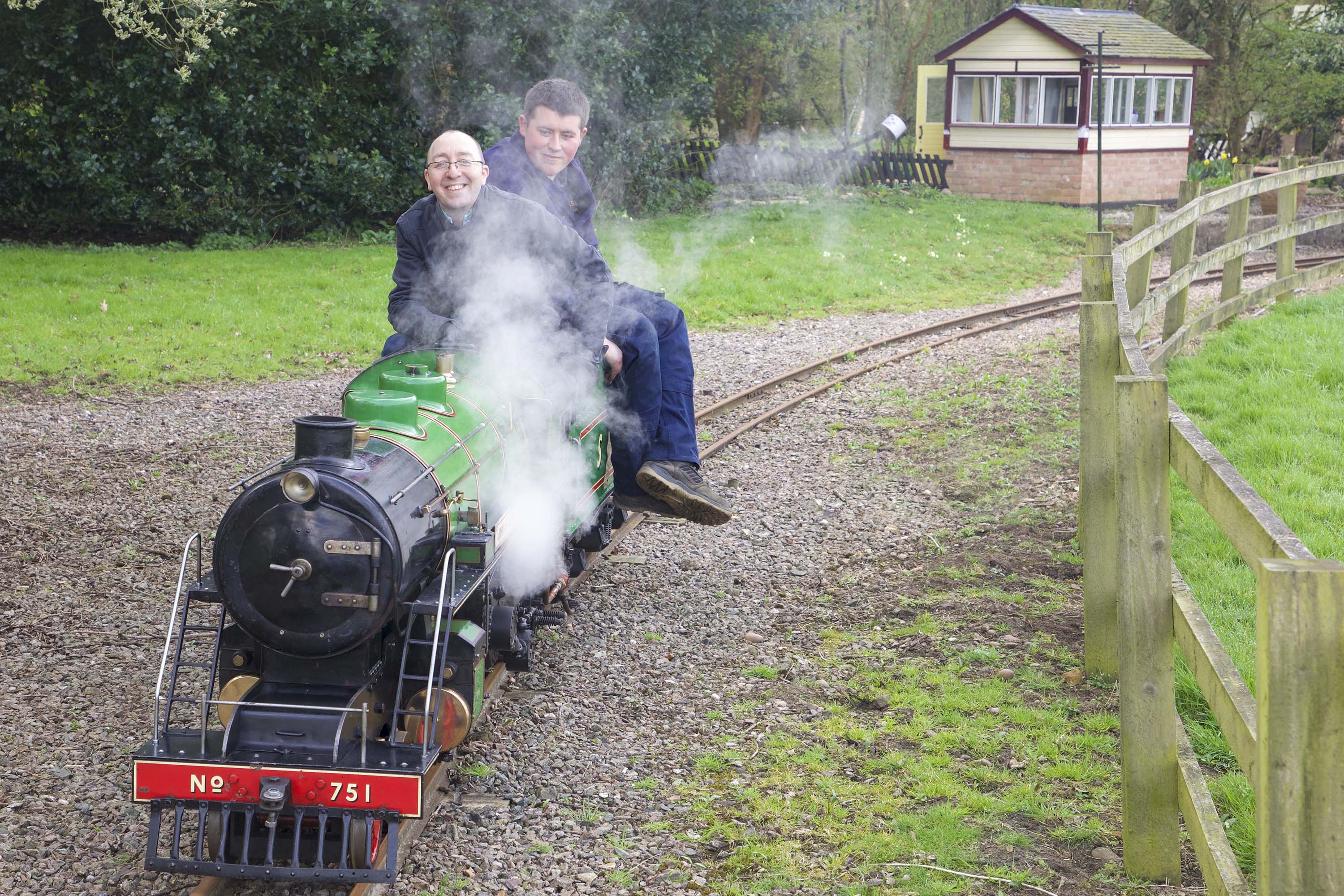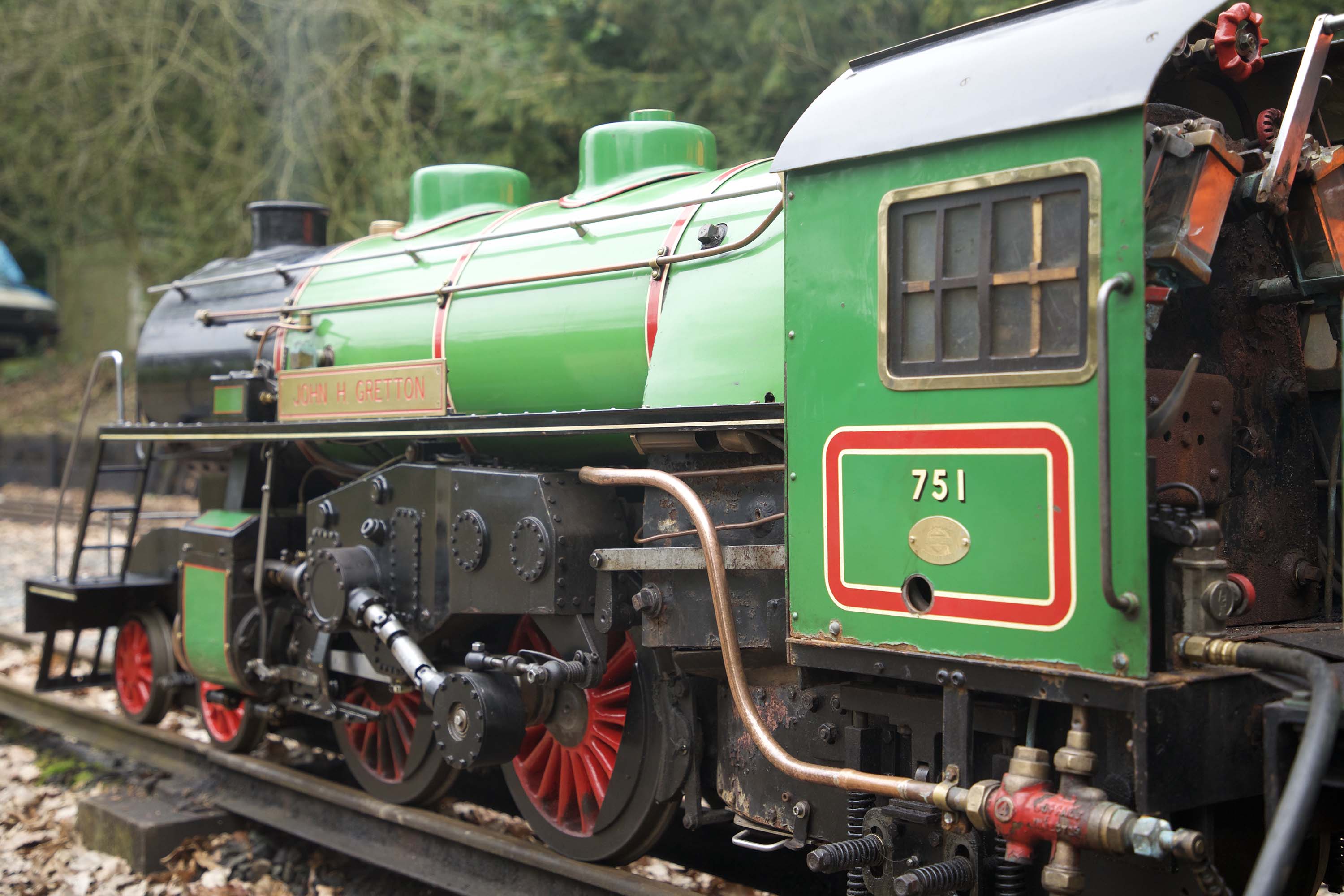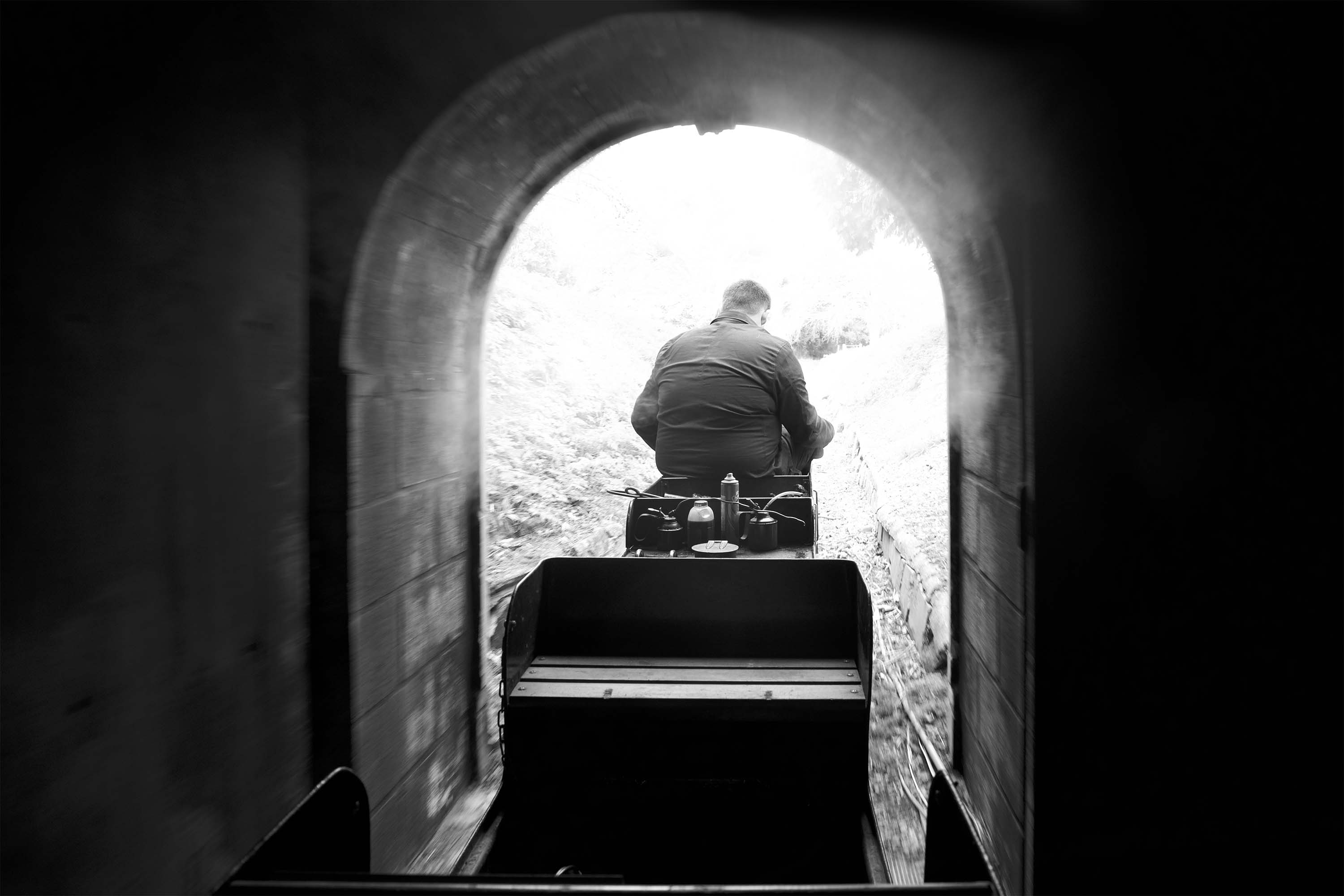
Letting Off Steam
This month the Stapleford Miniature Railway gain an apprentice to help run out their steam locomotive, John H Gretton. It’s a chance to see the railway up close and find out more prior to this month’s open day on 10th & 11th June…

Not so many years ago, if you asked a wide-eyed schoolboy what they wanted to be when they grew up, the answer would be, for example, a spaceman dressed in a tinfoil suit heading off to the moon, or a train driver standing on the footplate of a steam locomotive.
Sadly, these days most of them want to be TikTok influencers or YouTubers. But for a particular generation who never quite shook off the fantasy of oily overalls and the ‘peep-peep’ of a locomotive whistle, travelling by steam still evokes excitement, inspired by Brief Encounter, by the Venice Simplon Orient Express, or perhaps by the Mallard’s 126mph record near Grantham in 1938, or perhaps even just the idyllic adventures of Thomas the Tank Engine and his chums on the island of Sodor.
Travelling by steam train retains a visceral sense of romance and drama never quite repeated by contemporary transport. But happily, you can still enjoy the sounds, scent and almost meditative clickety-clack of a steam train on rails at about 100 ‘miniature’ heritage railways across the UK, not least among which is the Stapleford Miniature Railway.
The railway only opens to the public for a few steaming fixtures a year. One of the biggest and most popular events in its calendar take place on 10th & 11th June and 29th & 30th July, then for a Steam Rally during the August bank holiday with classic cars and motorcycles, traction engines, a fun fair, bar, trade stalls and much more.
But the event’s biggest draw will definitely be the chance for families and steam enthusiasts to enjoy a two-mile steam train journey along the railway courtesy of one of the group’s five coal-fired, one oil-fired or one heritage diesel locomotives. Steam trains especially necessitate rather more love, preparation and skill than the car in your garage, and so the Friends of Stapleford Miniature Railway are constantly giving their heritage locomotives attention to ensure they remain in good condition.
On Easter Sunday the volunteers gained probably the worst apprentice they’ve ever encountered as I visited to help prepare their 1948 Curwen Green Atlantic locomotive – renamed John H Gretton after the 3rd Lord Gretton – for a few trips around the railway.
It takes about an hour and a half to steam up from cold, a process that’s necessarily steady to prevent thermal shock damage to the boiler. Plenty of time, then, to talk to the railway’s Nigel Spencer and today’s driver Dean Allsopp about the railway and to undertake a bit of polishing.
“The adjacent Stapleford Park and its grounds were opened to the public by the second Lord Gretton in 1953 and he was looking for an additional attraction for visitors,” says Nigel. “He purchased (second hand) two steam locomotives, six coaches and 2,000ft of track.”
“The first line from the Old Stable Hill station to the Hall opened in 1958, with the first extension to the Lake opening in 1959. By the end of 1962, over 21,000 people every year were enjoying travelling on the railway. Following the sale of the house in 1985 and its transformation into a country house hotel, the railway was put into storage until Jennifer, Lady Gretton, the wife of the late 3rd Lord Gretton and their son, the current Lord Gretton sought a group of enthusiasts to restore and preserve the railway.”
I’m listening of course, but also working hard. Into my hand an unlikely tool in the armament of a steam railway enthusiast has been thrust. It’s a red can of Mr Sheen. My job is to polish up the locomotive and then polish the brass nameplate with a rag and a tin of Brasso. The latter seems a bit more appropriate as a cleaning product, somehow.
All the while, the coal has been loaded into the firebox and the engine is warming up nicely. There’s a bit of a chill in the air so I’m grateful to be close to the cosy engine, which is sufficiently insulated to retain its heat, becoming warm but not burning hot to the touch.
The group’s engines are stored in a large shed with a traverser – a short length of rails on a wooden platform which slides horizontally across the shed – helping to manoeuvre a particular engine out of the shed an onto the rails.
Once out of the loco shed, kindling and coal are used to get the fire started, with water added to the rear tank. Once up to steam, the engine makes its way to the station awaiting carriages, passengers and a top-up of water.
As any heritage railway enthusiast will tell you, not all coal is equal. Our Welsh dry steam anthracite coal has a sufficient calorific value to generate the best heat: after all, it’s steam and therefore heat that we’re seeking, not smoke, as generated in greater volume by lignite or bituminous coal.
The gases from all of that lovely heat, about 1,000°c in temperature, move through the flues or tubes in the main boiler vessel which contains water and boil it into steam to a very specific pressure. The steam rises through the steam dome, down the dry pipe and into the valve through which, via a piston, the driving wheels gain their ability to turn.
The driver therefore needs to keep the fire stoked but this isn’t simply a case of shovelling in coal like mad; it’s more about keeping an eye out to ensure there’s sufficient temperature to keep the boiler producing steam and anticipating when extra power will be needed – on uphill gradients, for example.
In front of me is the regulator which controls the amount of steam entering the cylinders, and a couple of glass water gauges. It’s imperative that these contain water at all time to prevent the whole engine from exploding. As well as speaking with Nigel and Dean, we’ve been joined by Nigel Harris, Rail Magazine’s editor who soberly underwrites this warning by pointing out that we’re basically sitting on a pressurised vessel which must not be allowed to run dry.
In addition to the regulator, there’s a lever for engaging a reverse or forward direction of movement, a brake and of course the delightful lever which makes the engine call out with that ‘peep-peep’ sound for which we all have such affection.
Nearly up to temperature and Nigel Spencer continues to tell me about the railway. With about two miles of track, a journey around the estate takes about 20 minutes. The group not only have to build or maintain the engines they run but also take care of the land adjacent to the track. The railway line is created to one-fifth scale – in other words, 20% of the size of a full-scale railway – with a 10 ¼” gauge (the width of the rails) which is one of a few adhered-to standards.
Pretty much all of the principles, mechanics and safety procedures, though, are identical to that of a full-sized steam railway. For instance, the driver must be in physical possession of a ‘token’ which is an object that grants ‘ownership’ of a particular section of track. Without that, they can’t proceed and just like a full-size railway, not possessing a token or passing a signal at danger carries serious consequences.
There are no ‘standard parts’ or off-the-shelf locomotives for miniature railways, either, so as well as running the railway, and operating the engines, the group has to maintain the line, clearing leaves for example and managing the area surrounding the track, including the railway’s 80-metre tunnel.
These days, in the event of needing to create a new engine, it’s possible to exchange schematics online, but designs and engineering requirements vary to such a degree that each locomotive ends up becoming a one-odd bespoke engineering project.
Also in the loco shed is the New York Chicago and St Louis Berkshire class loco, built at Stapleford by Richard Coleby, Bob Moore and Neil Simkins in 1970/1971, the construction of it was a two-year full-time job for three engineers. Weighing in at two tonnnes, it’ll pull 10 tonnes of carriages and passengers, so to say it’s ‘miniature’ it still has a heck of a lots of power.
Meanwhile, from its original construction in 1948, the locomotive that we’ll be running today may have been constructed in Marlborough but it has been modified and re-engineered constantly by the group at Stapleford.
Locomotives are referred to by their wheel arrangement, and so in our case, John H Gretton is a 4-4-2 locomotive with four smaller wheels carrying the steering bogie, four powered wheels and two trailing wheels to support the firebox.
We’re up to temperature not just on the locomotive but outdoors too. The mist has burnt off, the sun is trying to shine down on the spring bulbs and there’s even a bit of blue sky.
Dean climbs aboard, pushes forward on the gears, notches the selector into place and gently eases the regulator to take the engine a couple of hundred yards up to the station. There, we await the carriages and I’m tasked with filling up the tender with water.
Like the rest of the railway, the team has built and maintain the ticket office and station. Still working with its President Jennifer, Lady Gretton and the owner, the current Lord Gretton, the FSMR supports LOROS and has donated nearly £100,000 to the hospice, which provides care and support for terminally ill patients and their families, since partnering with them in 1995.
Our journey around the railway begins, taking in the group’s tunnel, sights of the lake, open farmland and Stapleford Park in the middle-distance. A couple of pheasants skittishly cross the line during our journey and a squirrel scampers up a tree. Throughout the journey the motion, the warmth and the scent of the coal burning in the engine creates that visceral rewarding experience long since lost to diesel power.
Back at the station, I’m offered the chance to sit in the driver’s seat, nervously acknowledging that the locomotive is completely unique and priceless. Nonetheless, with a steady easing of the regulator, the enormously long train with its carriages gently moves forward.
There’s not a biting point like a car’s clutch, but certainly a driver senses the point where you can feel the pressure is sufficient and you’re on the cusp of movement.
I’m very judicious with my use of the control, and keener still when it’s time to reverse back into the station and not crash a carriage or two through the barriers. Reversing is unfeasibly challenging given how long the train is with nine carriages and given that a driver needs to ease off the throttle at just the right time and just coast back into the station… I certainly wouldn’t fancy parallel parking the thing!
Still, I’ve driven a train – actually driven a steam train – and I feel utterly privileged to have been entrusted with the group’s priceless locomotive. Even among just a small number of enthusiasts during my visit, the feeling of nostalgia and affection for the railway is palpable.
When the group opens its carriage doors to passengers for June’s steaming event, for its Salute to the 1940s event in July and for its Vintage Steam Rally over the August bank holiday, the atmosphere is set to be even greater, reminding passengers that the halcyon days of steam travel are just as exciting and enjoyable as ever!
Find Out More: Stapleford Park Miniature Railway is open for its steaming day on 10th & 11th June, then for its Salute to the 1940s from 29th – 30th July and for its steam rally during August’s bank holiday with a fairground, classic cars, and more. For information about the group, see www.fsmr.co.uk







